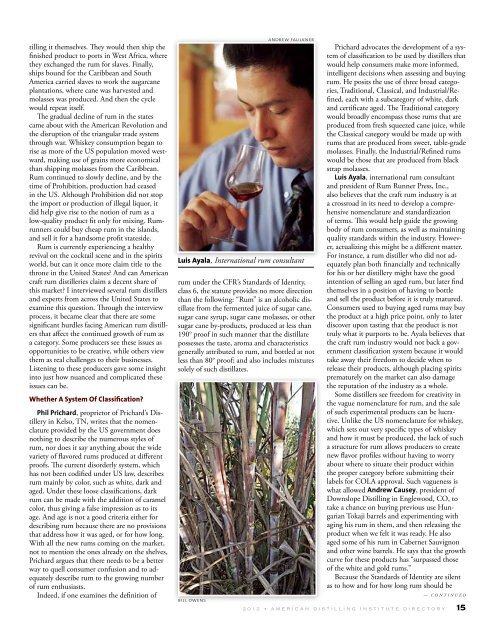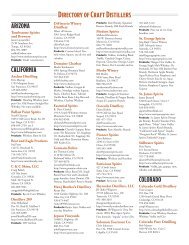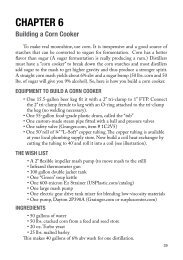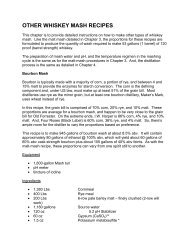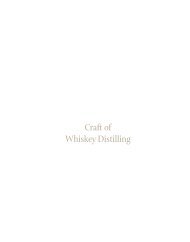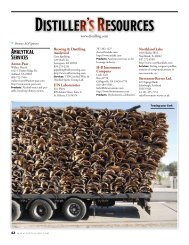502-320-6419 - The American Distilling Institute
502-320-6419 - The American Distilling Institute
502-320-6419 - The American Distilling Institute
You also want an ePaper? Increase the reach of your titles
YUMPU automatically turns print PDFs into web optimized ePapers that Google loves.
tilling it themselves. <strong>The</strong>y would then ship the<br />
finished product to ports in West Africa, where<br />
they exchanged the rum for slaves. Finally,<br />
ships bound for the Caribbean and South<br />
America carried slaves to work the sugarcane<br />
plantations, where cane was harvested and<br />
molasses was produced. And then the cycle<br />
would repeat itself.<br />
<strong>The</strong> gradual decline of rum in the states<br />
came about with the <strong>American</strong> Revolution and<br />
the disruption of the triangular trade system<br />
through war. Whiskey consumption began to<br />
rise as more of the uS population moved westward,<br />
making use of grains more economical<br />
than shipping molasses from the Caribbean.<br />
Rum continued to slowly decline, and by the<br />
time of Prohibition, production had ceased<br />
in the uS. Although Prohibition did not stop<br />
the import or production of illegal liquor, it<br />
did help give rise to the notion of rum as a<br />
low-quality product fit only for mixing. Rumrunners<br />
could buy cheap rum in the islands,<br />
and sell it for a handsome profit stateside.<br />
Rum is currently experiencing a healthy<br />
revival on the cocktail scene and in the spirits<br />
world, but can it once more claim title to the<br />
throne in the united States? And can <strong>American</strong><br />
craft rum distilleries claim a decent share of<br />
this market? I interviewed several rum distillers<br />
and experts from across the united States to<br />
examine this question. Through the interview<br />
process, it became clear that there are some<br />
significant hurdles facing <strong>American</strong> rum distillers<br />
that affect the continued growth of rum as<br />
a category. Some producers see these issues as<br />
opportunities to be creative, while others view<br />
them as real challenges to their businesses.<br />
Listening to these producers gave some insight<br />
into just how nuanced and complicated these<br />
issues can be.<br />
Whether A System Of Classification?<br />
Phil Prichard, proprietor of Prichard’s Distillery<br />
in Kelso, tN, writes that the nomenclature<br />
provided by the uS government does<br />
nothing to describe the numerous styles of<br />
rum, nor does it say anything about the wide<br />
variety of flavored rums produced at different<br />
proofs. <strong>The</strong> current disorderly system, which<br />
has not been codified under uS law, describes<br />
rum mainly by color, such as white, dark and<br />
aged. under these loose classifications, dark<br />
rum can be made with the addition of caramel<br />
color, thus giving a false impression as to its<br />
age. And age is not a good criteria either for<br />
describing rum because there are no provisions<br />
that address how it was aged, or for how long.<br />
With all the new rums coming on the market,<br />
not to mention the ones already on the shelves,<br />
Prichard argues that there needs to be a better<br />
way to quell consumer confusion and to adequately<br />
describe rum to the growing number<br />
of rum enthusiasts.<br />
Indeed, if one examines the definition of<br />
Luis Ayala, International rum consultant<br />
rum under the CFR’s Standards of Identity,<br />
class 6, the statute provides no more direction<br />
than the following: “Rum” is an alcoholic distillate<br />
from the fermented juice of sugar cane,<br />
sugar cane syrup, sugar cane molasses, or other<br />
sugar cane by-products, produced at less than<br />
190° proof in such manner that the distillate<br />
possesses the taste, aroma and characteristics<br />
generally attributed to rum, and bottled at not<br />
less than 80° proof; and also includes mixtures<br />
solely of such distillates.<br />
bill owenS<br />
andrew Faulkner<br />
Prichard advocates the development of a system<br />
of classification to be used by distillers that<br />
would help consumers make more informed,<br />
intelligent decisions when assessing and buying<br />
rum. He posits the use of three broad categories,<br />
traditional, Classical, and Industrial/Refined,<br />
each with a subcategory of white, dark<br />
and certificate aged. <strong>The</strong> traditional category<br />
would broadly encompass those rums that are<br />
produced from fresh squeezed cane juice, while<br />
the Classical category would be made up with<br />
rums that are produced from sweet, table-grade<br />
molasses. Finally, the Industrial/Refined rums<br />
would be those that are produced from black<br />
strap molasses.<br />
Luis Ayala, international rum consultant<br />
and president of Rum Runner Press, Inc.,<br />
also believes that the craft rum industry is at<br />
a crossroad in its need to develop a comprehensive<br />
nomenclature and standardization<br />
of terms. This would help guide the growing<br />
body of rum consumers, as well as maintaining<br />
quality standards within the industry. However,<br />
actualizing this might be a different matter.<br />
For instance, a rum distiller who did not adequately<br />
plan both financially and technically<br />
for his or her distillery might have the good<br />
intention of selling an aged rum, but later find<br />
themselves in a position of having to bottle<br />
and sell the product before it is truly matured.<br />
Consumers used to buying aged rums may buy<br />
the product at a high price point, only to later<br />
discover upon tasting that the product is not<br />
truly what it purports to be. Ayala believes that<br />
the craft rum industry would not back a government<br />
classification system because it would<br />
take away their freedom to decide when to<br />
release their products, although placing spirits<br />
prematurely on the market can also damage<br />
the reputation of the industry as a whole.<br />
Some distillers see freedom for creativity in<br />
the vague nomenclature for rum, and the sale<br />
of such experimental products can be lucrative.<br />
unlike the uS nomenclature for whiskey,<br />
which sets out very specific types of whiskey<br />
and how it must be produced, the lack of such<br />
a structure for rum allows producers to create<br />
new flavor profiles without having to worry<br />
about where to situate their product within<br />
the proper category before submitting their<br />
labels for COLA approval. Such vagueness is<br />
what allowed Andrew Causey, president of<br />
Downslope <strong>Distilling</strong> in Englewood, CO, to<br />
take a chance on buying previous use Hungarian<br />
tokaji barrels and experimenting with<br />
aging his rum in them, and then releasing the<br />
product when we felt it was ready. He also<br />
aged some of his rum in Cabernet Sauvignon<br />
and other wine barrels. He says that the growth<br />
curve for these products has “surpassed those<br />
of the white and gold rums.”<br />
Because the Standards of Identity are silent<br />
as to how and for how long rum should be<br />
— C O N T I N U E D<br />
2 0 1 2 • a m e r i c a n d i s t i l l i n g i n s t i t u t e d i r e c t o r y<br />
15


